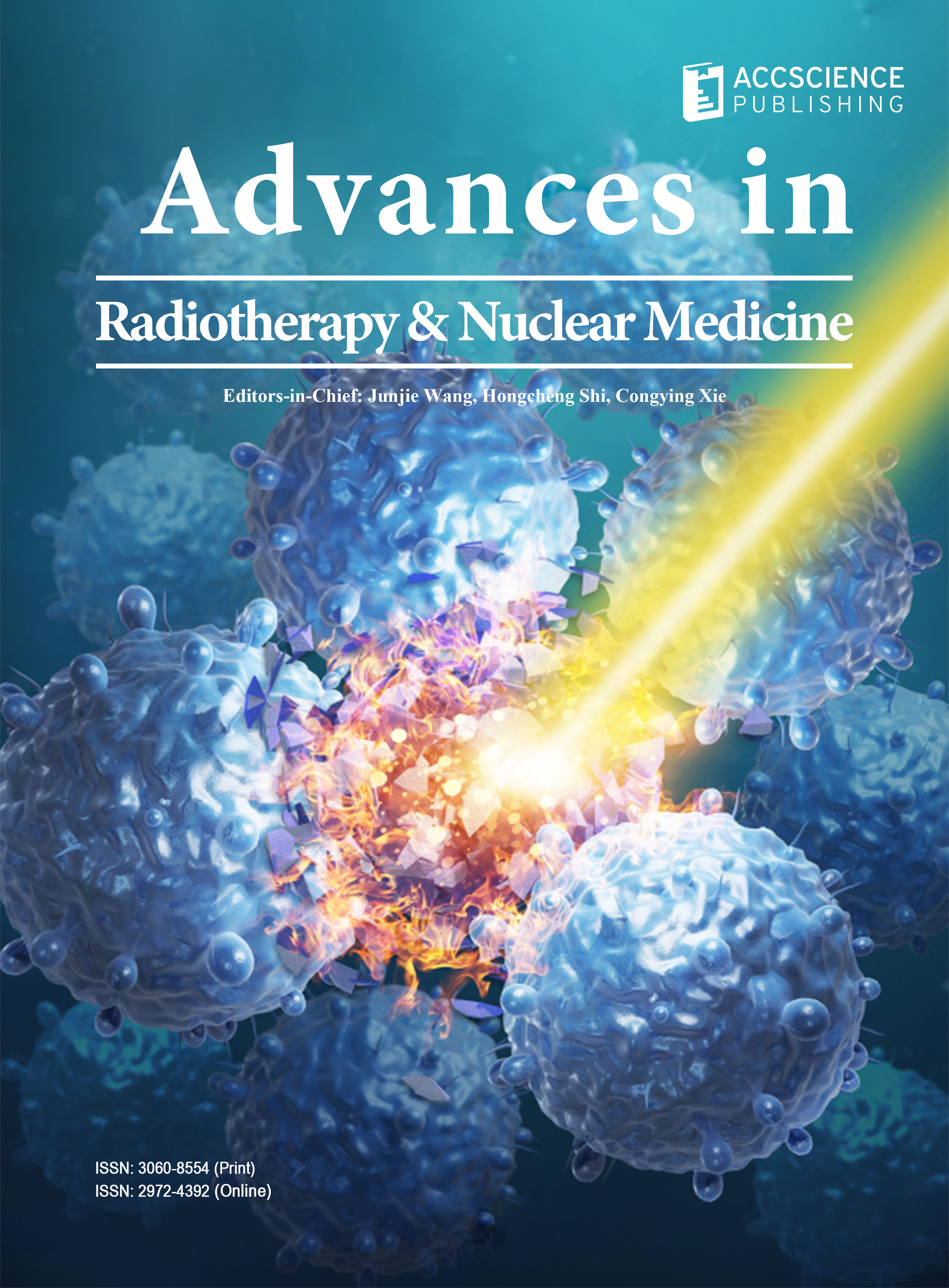Evaluating the efficacy of immunochemoradiotherapy in malignant pleural mesothelioma and distinguishing benign from malignant lymph nodes using 18F-FDG PET/CT and 18F-FAPI-04 PET/CT imaging: A case report

In this paper, we report a case of pleural mesothelioma, imaged employing 18F-fluorodeoxyglucose (FDG) positron emission tomography/computed tomography (PET/CT), and 18F-fibroblast activating protein inhibitor (FAPI)-04 PET/CT. The diagnosis of pleural mesothelioma was confirmed by histopathologically examining the thoracoscopic biopsy. The patient underwent an 18F-FDG PET/CT before immunochemoradiotherapy, followed by an 18F-FAPI-04 imaging 3 months after treatment. The changes in focal anatomy, morphology, and metabolic biology observed between the two distinct PET/CT imaging modalities can aid in distinguishing benign and malignant lymph nodes and assessing treatment efficacy. This case highlights the diagnostic utility of 18F-FDG PET/C in pleural mesothelioma and suggests that 18F-FAPI-04 PET/CT may serve as an effective tool for evaluating the outcomes of immunochemotherapy. Moreover, the combined application of 18F-FDG PET/CT and 18F-FAPI-04 PET/CT holds promise for the differentiation of benign and malignant lymph nodes.
- Hathi DK, Jones EF, 2019, 68Ga FAPI PET/CT: Tracer uptake in 28 different kinds of cancer. Radiol Imaging Cancer, 1: e194003. https://doi.org/10.1148/rycan.2019194003
- Mona CE, Benz MR, Hikmat F, et al., 2022, Correlation of 68Ga-FAPi-46 PET biodistribution with FAP expression by immunohistochemistry in patients with solid cancers: Interim analysis of a prospective translational exploratory study. J Nucl Med, 63: 1021–1026. https://doi.org/10.2967/jnumed.121.262426
- Giesel FL, Kratochwil C, Schlittenhardt J, et al., 2021, Head-to-head intra-individual comparison of biodistribution and tumor uptake of 68Ga-FAPI and 18F-FDG PET/CT in cancer patients. Eur J Nucl Med Mol Imaging, 48: 4377–4385. https://doi.org/10.1007/s00259-021-05307-1
- Gundogan C, Guzel Y, Komek H, et al., 2022, 68Ga-FAPI-04 PET/CT versus 18F-FDG PET/CT in malignant peritoneal mesothelioma. Clin Nucl Med, 47: e113–e115. https://doi.org/10.1097/RLU.0000000000003858
- Kessler L, Ferdinandus J, Hirmas N, et al., 2022, 68Ga-FAPI as a diagnostic tool in sarcoma: Data from the 68Ga-FAPI PET prospective observational trial. J Nucl Med, 63: 89–95. https://doi.org/10.2967/jnumed.121.262096
- Treglia G, Muoio B, Roustaei H, et al., 2021, Head-to-head comparison of fibroblast activation protein inhibitors (FAPI) radiotracers versus [18F]F-FDG in oncology: A systematic review. Int J Mol Sci, 22: 11192. https://doi.org/10.3390/ijms222011192
- Armato SG 3rd, Labby ZE, Coolen J, et al., 2013, Imaging in pleural mesothelioma: A review of the 11th International Conference of the International Mesothelioma Interest Group. Lung Cancer, 82: 190–196. https://doi.org/10.1016/j.lungcan.2013.08.005
- Armato SG 3rd, Ogarek JL, Starkey A, et al., 2006, Variability in mesothelioma tumor response classification. AJR Am J Roentgenol, 186: 1000–1006. https://doi.org/10.2214/AJR.05.0076
- Oxnard GR, Armato SG 3rd, Kindler HL, 2006, Modeling of mesothelioma growth demonstrates weaknesses of current response criteria. Lung Cancer, 52: 141–148. https://doi.org/10.1016/j.lungcan.2005.12.013
- Ceresoli GL, Chiti A, Zucali PA, et al., 2007, Assessment of tumor response in malignant pleural mesothelioma. Cancer Treat Rev, 33: 533–541. https://doi.org/10.1016/j.ctrv.2007.07.012
- Lopci E, Zucali PA, Ceresoli GL, et al., 2015, Quantitative analyses at baseline and interim PET evaluation for response assessment and outcome definition in patients with malignant pleural mesothelioma. Eur J Nucl Med Mol Imaging, 42: 667–675. https://doi.org/10.1007/s00259-014-2960-y
- Spitilli MG, Treglia G, Calcagni ML, et al., 2007, Malignant pleural mesothelioma: Utility of 18 F-FDG PET. Ann Ital Chir, 78: 393–396.
- Sandach P, Seifert R, Fendler WP, et al., 2022, A role for PET/CT in response assessment of malignant pleural mesothelioma. Semin Nucl Med, 52: 816–823. https://doi.org/10.1053/j.semnuclmed.2022.04.008
- Kitajima K, Doi H, Kuribayashi K, 2016, Present and future roles of FDG-PET/CT imaging in the management of malignant pleural mesothelioma. Jpn J Radiol, 34: 537–547. https://doi.org/10.1007/s11604-016-0555-1
- Dong A, Zhao B, Cheng C, et al., 2022, 68 Ga-FAPI-04 versus 18 F-FDG PET/CT in detection of epithelioid malignant pleural mesothelioma. Clin Nucl Med, 47: 980–981. https://doi.org/10.1097/RLU.0000000000004269
- Li J, Yang J, Hu S, 2023, Malignant peritoneal mesothelioma with butterfly-shaped muscle metastasis: 68Ga-FAPI PET/ CT versus 18F-FDG PET/CT. Clin Nucl Med, 48: 348–350. https://doi.org/10.1097/RLU.0000000000004575
- Guzel Y, Komek H, Can C, et al., 2023, Comparison of the role of 18 F-fluorodeoxyglucose PET/computed tomography and 68 Ga-labeled FAP inhibitor-04 PET/CT in patients with malignant mesothelioma. Nucl Med Commun, 44: 631–639. https://doi.org/10.1097/MNM.0000000000001702
- Hu K, Wang L, Wu H, et al., 2022, [18F]FAPI-42 PET imaging in cancer patients: Optimal acquisition time, biodistribution, and comparison with [68Ga]Ga-FAPI-04. Eur J Nucl Med Mol Imaging, 49: 2833–2843. https://doi.org/10.1007/s00259-021-05646-z
- Shu Q, Deng M, Hu M, et al., 2023, The additional role of [68Ga]Ga-FAPI-04 PET/CT in patients with unknown primary lesion with a negative or equivocal [18F]FDG. Eur J Nucl Med Mol Imaging, 50: 1442–1452. https://doi.org/10.1007/s00259-022-06095-y

